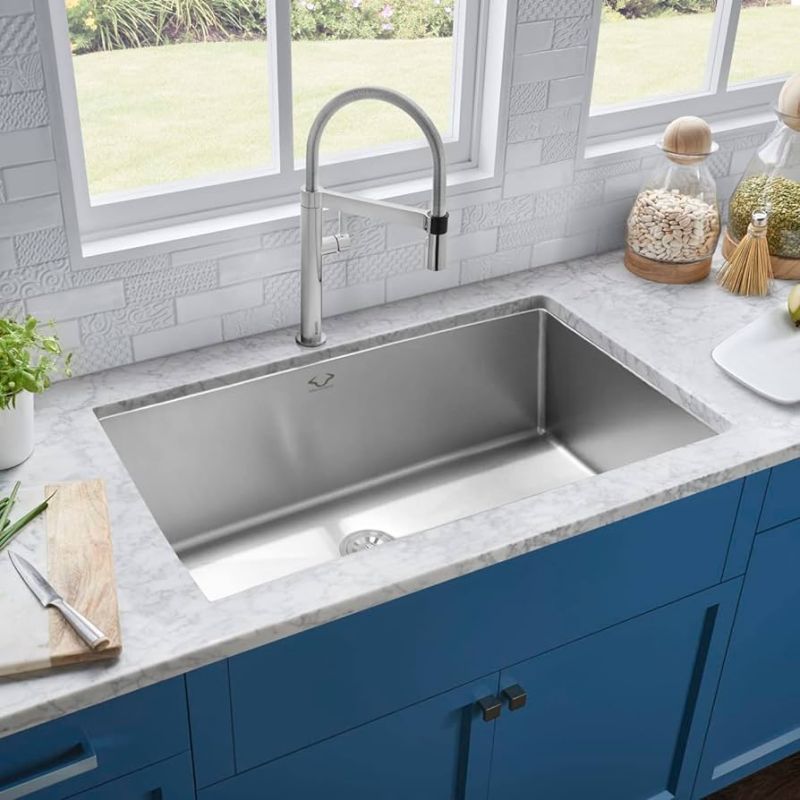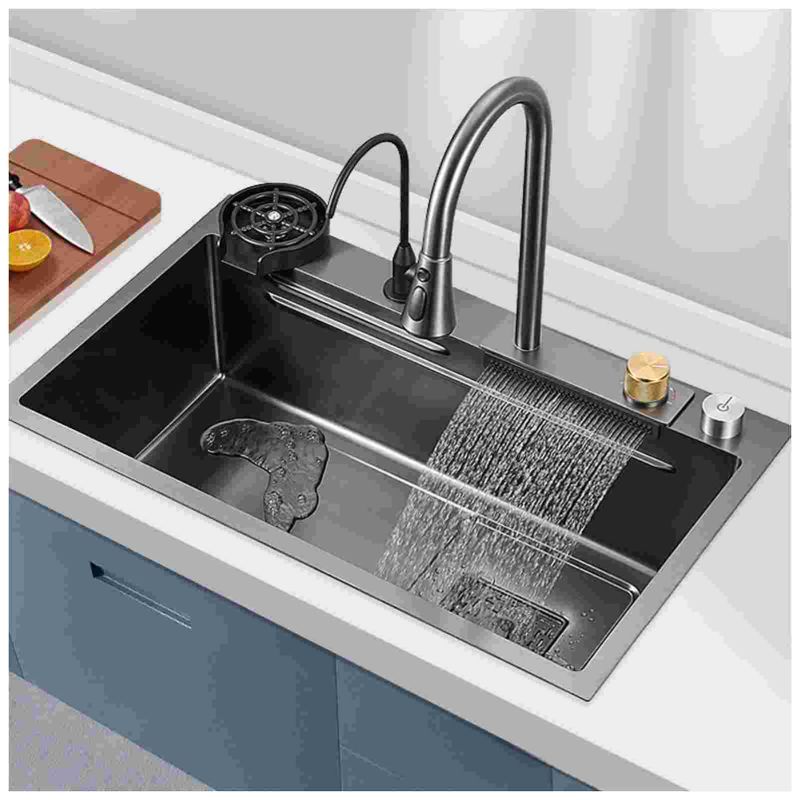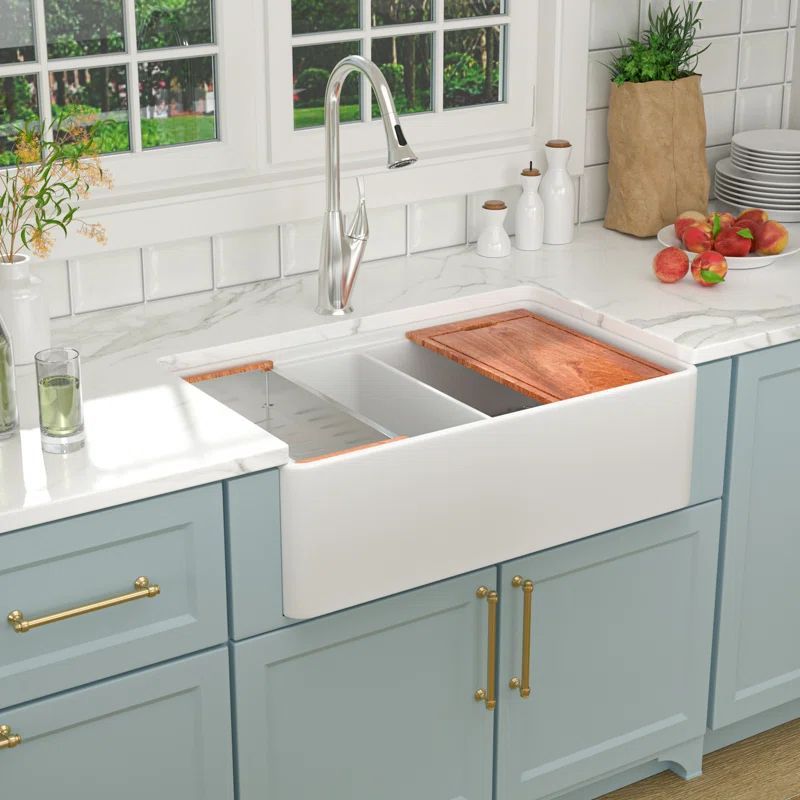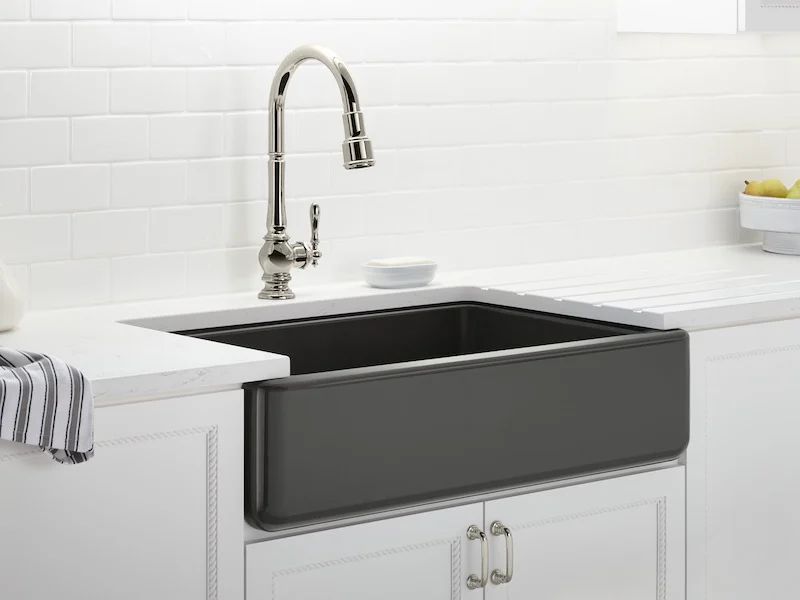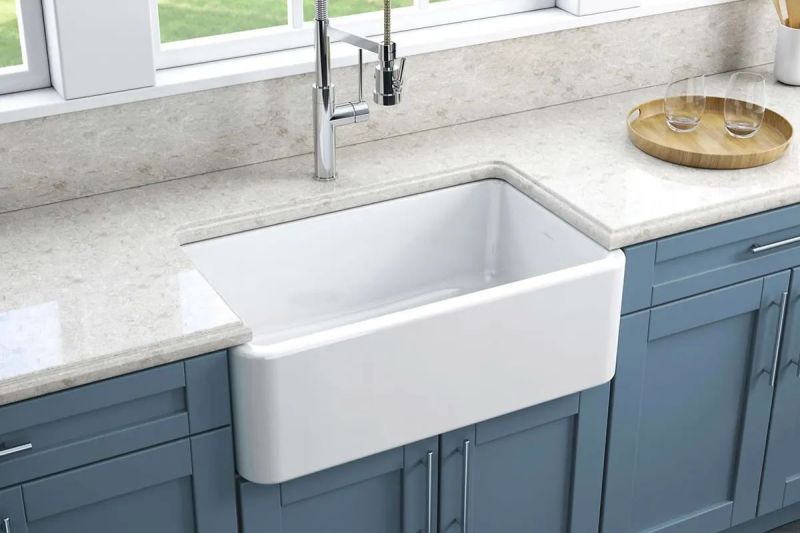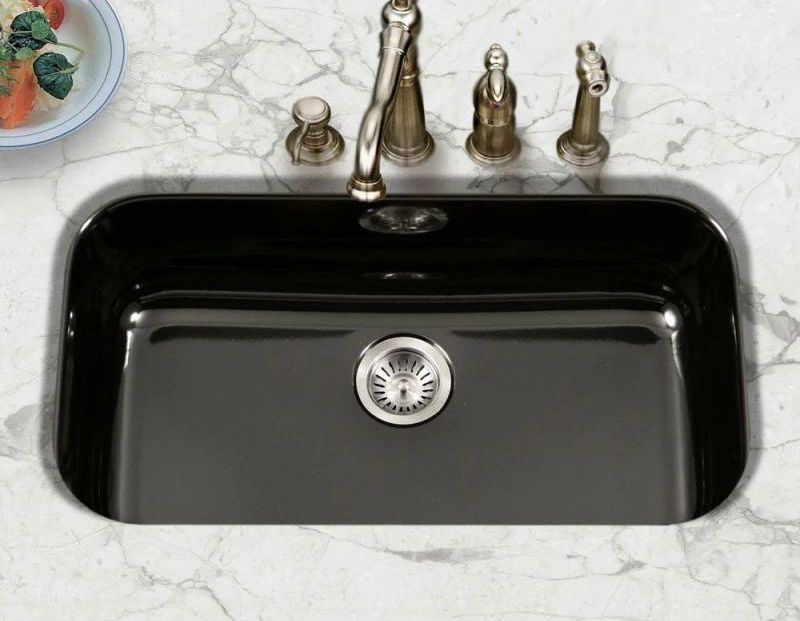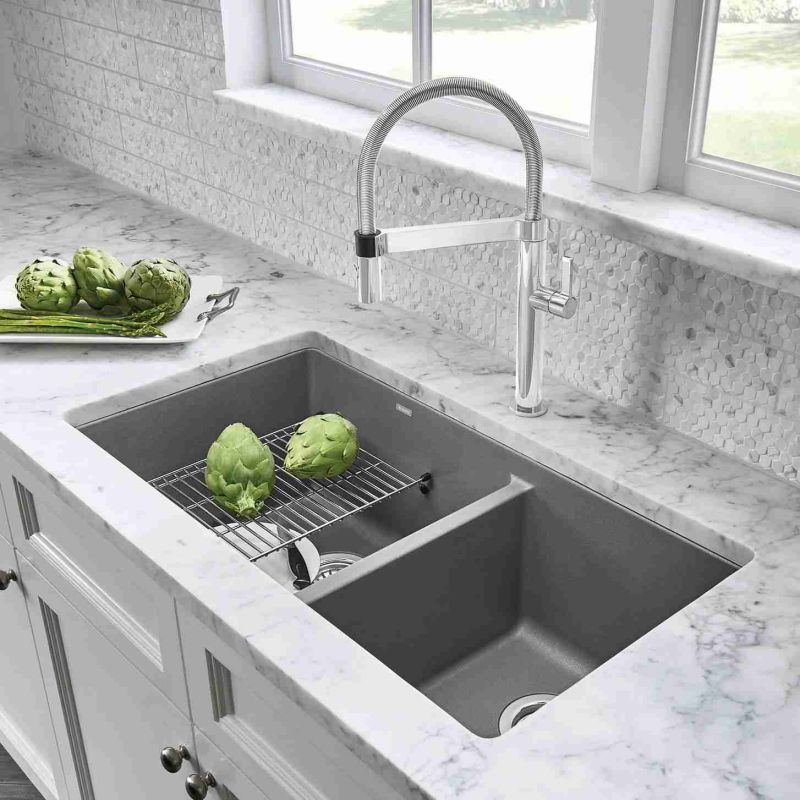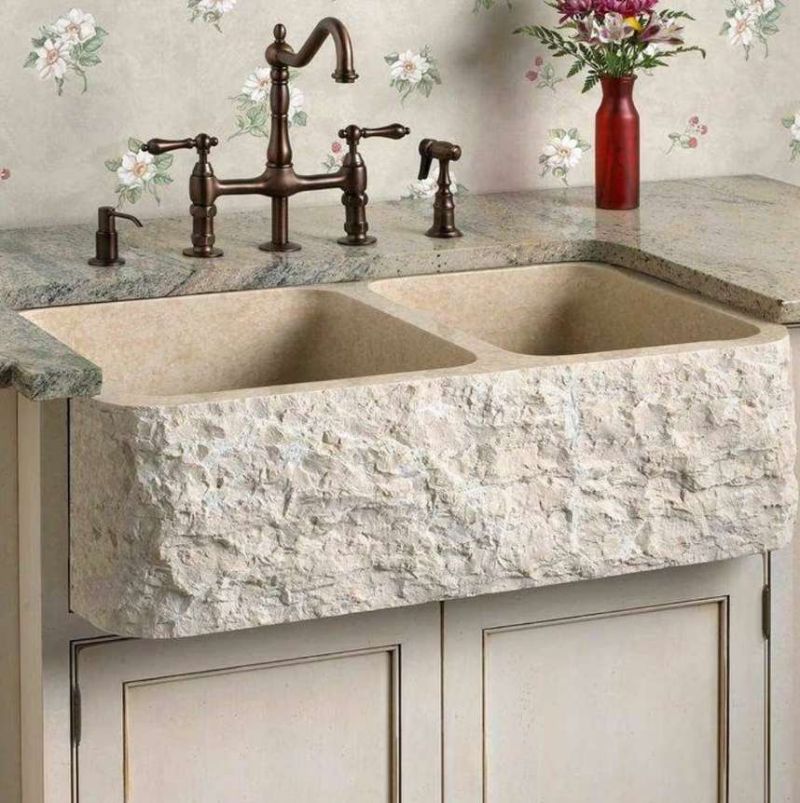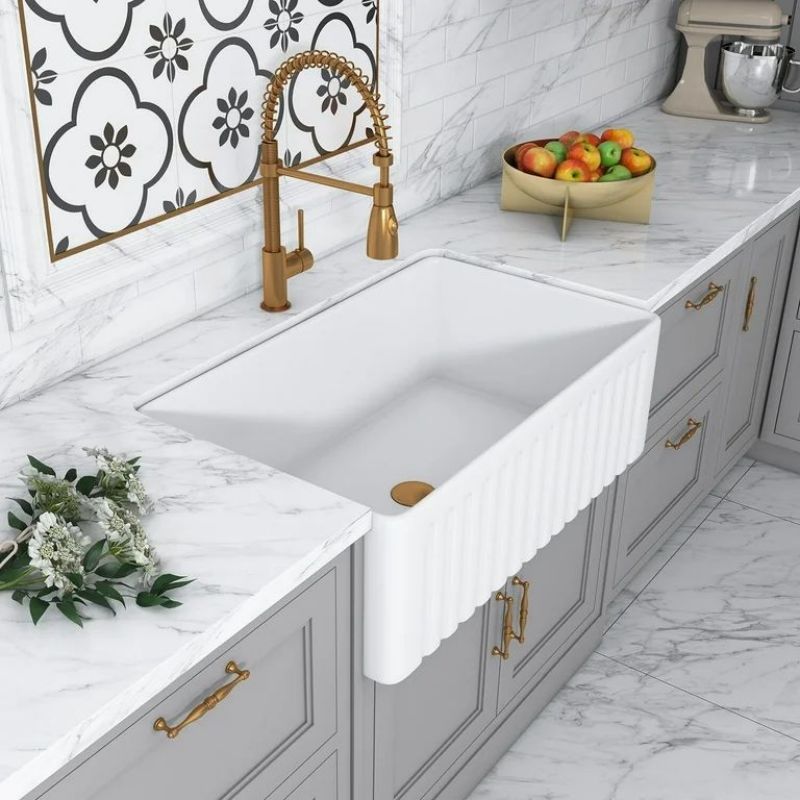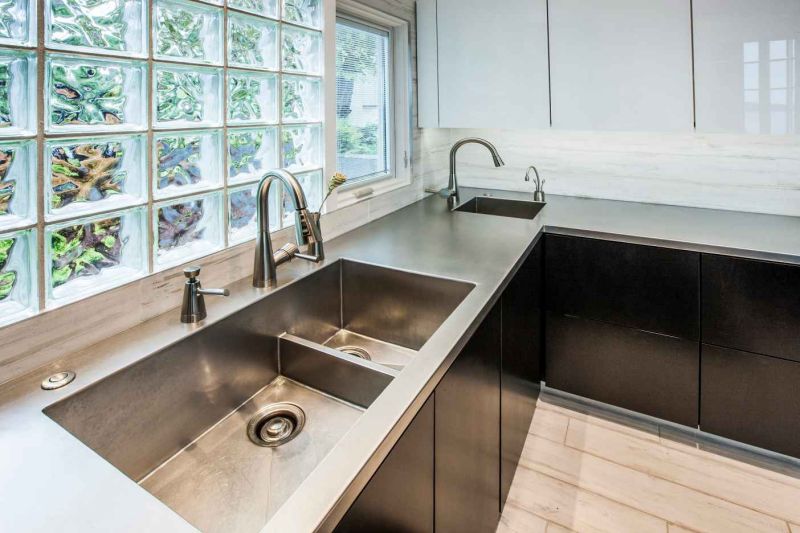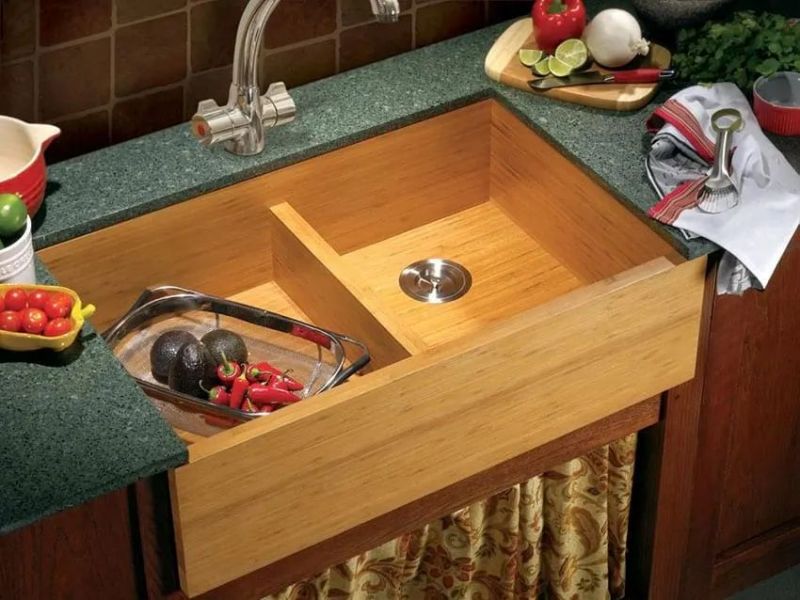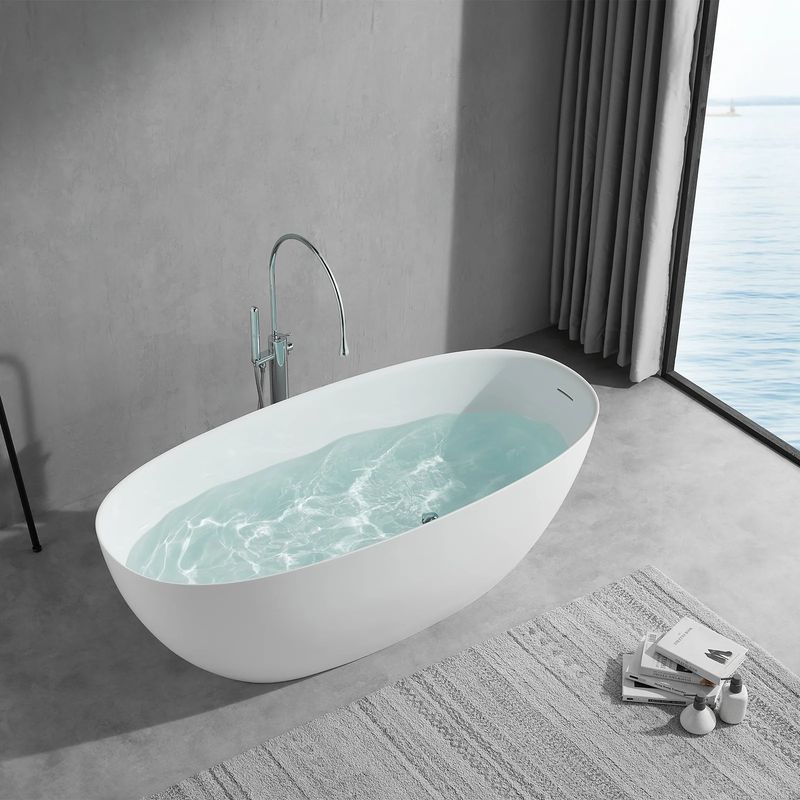 English
English
Jabra Sanitary is a sanitaryware supplier offering toilets, sinks, faucets, bathtubs, etc., at competitive prices. If you're a distributor, wholesaler, or project contractor, get a quote today!
 $23.9 Limited-time Offer
$23.9 Limited-time Offer Consignment Policy
Consignment Policy 20 Years of Experience
20 Years of Experience
The kitchen sink is one of the most frequently used fixtures in any home. What are kitchen sinks made of? With a wide range of materials available, from classic stainless steel to luxurious granite composites, selecting the right kitchen sink can significantly impact your kitchen's overall look, durability, and ease of maintenance.
In this guide, we'll explore the pros and cons of the most popular kitchen sink materials, helping you choose the best kitchen sink materials that suits your needs and lifestyle.
Table of Contents
Stainless Steel Kitchen Sinks
Ceramic Kitchen Sinks
Cast Iron Kitchen Sinks
Fireclay Kitchen Sinks
Copper Kitchen Sinks
Porcelain Enamel Kitchen Sinks
Quartz Composite Kitchen Sinks
Granite Composite Kitchen Sinks
Acrylic Resin Kitchen Sinks
Stone Kitchen Sinks
Vitreous China Kitchen Sinks
Brass Kitchen Sinks
Bronze Kitchen Sinks
Zinc Kitchen Sinks
Wood Kitchen Sinks
Compare Kitchen Sink Materials
How to Choose the Best Kitchen Sink Material
FAQs
Why Choose Jabra Sanitary Kitchen Sinks to Improve Your Business?
Conclusion
When choosing your kitchen sink, you can't go wrong with stainless steel. This top kitchen sink material is extremely durable and able to withstand heavy impacts from pots and pans while resisting scratches from sharp knives and utensils.
Stainless steel sinks also offer excellent hygiene benefits due to their antimicrobial properties and rust-resistant surface, making it easier to prevent contamination when preparing food or washing dishes. Additionally, stainless steel is both heat and stain-resistant, making it one of the easiest sink materials to clean and maintain.
However, one drawback is that stainless steel sinks can be noisy when dishes and utensils are dropped into them. Despite this, the numerous benefits of stainless steel make it a popular choice in many homes.
When choosing a stainless steel sink, pay attention to the gauge, which indicates the thickness of the steel. A lower gauge number means thicker steel. For durability, 16 to 18-gauge steel is recommended as it's tough, strong, and resistant to bending or buckling under heavy use. Another important factor is the series number of the steel, which tells you how the steel was manufactured and whether it's magnetic. The 300 series is generally the best choice for kitchen sinks as it's non-magnetic and contains chromium and nickel, which enhance corrosion and heat resistance.
Pros: Affordable, easy to clean and maintain, one of the most durable kitchen sink materials, rust-resistant, antimicrobial properties.
Cons: Can be noisy, shows water spots, prone to scratches.
Style: Modern, Farmhouse, Transitional, Traditional.
Cost: $-$$
Best For Stainless steel sinks are ideal for modern, farmhouse, and transitional kitchens where durability, ease of maintenance, and cost-effectiveness are key priorities. They are also perfect for high-traffic kitchens where hygiene is a concern.
How to Clean a Stainless Steel Sink
- Daily Cleaning: Wipe down the sink with a soft cloth and mild dish soap after each use. Rinse thoroughly with warm water to remove soap residue.
- Removing Stains: For tougher stains, use a paste made of baking soda and water. Apply it to the stain, scrub gently with a non-abrasive pad, and rinse thoroughly.
- Maintaining Shine: To restore shine, rub the sink with a few drops of olive oil or stainless steel cleaner using a microfiber cloth. Buff the surface until it shines.
Ceramic kitchen sinks are a popular choice for homeowners who want a blend of beauty and functionality. Known for their smooth, glossy finish, ceramic sinks add a touch of elegance to any kitchen.
They are highly resistant to stains, discoloration, and household chemicals, making them ideal for busy kitchens. Ceramic sinks also come in a variety of colors and styles, allowing you to find one that perfectly matches your kitchen decor.
However, ceramic sinks are heavier than many other sink materials, requiring sturdy cabinetry for support. They can also chip or crack if heavy objects are dropped into them, so they may not be the best choice for homes where the sink will see heavy use.
Pros: Aesthetic appeal, stain-resistant, available in a variety of designs and colors, easy to clean.
Cons: Prone to chipping, heavy, can crack under heavy impact.
Style: Traditional, Farmhouse, Vintage, Transitional.
Cost: $$-$$$
Best For: Ceramic sinks are best for traditional, farmhouse, and vintage-style kitchens where aesthetics and a classic look are prioritized. They are also ideal for homeowners who prefer a sink that offers a wide variety of design and color options.
How to Clean a Ceramic Sink
- Daily Cleaning: Use a soft cloth or sponge with mild dish soap to clean the sink's surface. Avoid using abrasive cleaners that could damage the glossy finish.
- Removing Stains: For persistent stains, sprinkle baking soda on the stain and scrub gently with a non-abrasive sponge. Rinse thoroughly with warm water.
- Maintaining the Finish: To keep your ceramic sink looking new, avoid dropping heavy objects into the sink. For added protection, use a sink mat to cushion dishes and cookware.
Cast Iron Kitchen Sinks
Cast iron kitchen sinks are synonymous with durability and classic charm. Coated with a layer of enamel, these sinks are not only strong but also resistant to heat, making them ideal for kitchens where hot pots and pans are frequently placed in the sink.
The glossy enamel finish provides a smooth, elegant appearance that can enhance the aesthetic of both traditional and modern kitchens.
However, cast iron sinks are extremely heavy, which means they require reinforced cabinetry. The enamel coating, while beautiful, can chip if heavy objects are dropped into the sink, exposing the iron underneath to potential rusting.
Pros: Long-lasting, heat retention, elegant appearance, highly durable.
Cons: Heavy, requires reinforced cabinetry, enamel coating can chip, expensive.
Style: Classic, Farmhouse, Traditional, Vintage.
Cost: $$-$$$$
Best For Cast iron sinks are ideal for classic, farmhouse, and traditional kitchens where durability and heat resistance are essential. They are also suitable for homeowners who appreciate a sink with a glossy, elegant appearance and are prepared to provide the necessary cabinetry support.
How to Clean a Cast Iron Sink
- Daily Cleaning: Clean the sink with a mild dish soap and a soft cloth or sponge. Avoid harsh chemicals that could damage the enamel coating.
- Removing Stains: For tougher stains, sprinkle baking soda over the stain and scrub gently with a non-abrasive pad. Rinse thoroughly.
- Protecting the Enamel: To prevent chipping, avoid dropping heavy objects into the sink. Consider using a sink grid to protect the surface.
Fireclay Kitchen Sinks
Cast iron kitchen sinks are synonymous with durability and classic charm. Coated with a layer of enamel, these sinks are not only strong but also resistant to heat, making them ideal for kitchens where hot pots and pans are frequently placed in the sink.
The glossy enamel finish provides a smooth, elegant appearance that can enhance the aesthetic of both traditional and modern kitchens.
However, cast iron sinks are extremely heavy, which means they require reinforced cabinetry. The enamel coating, while beautiful, can chip if heavy objects are dropped into the sink, exposing the iron underneath to potential rusting.
Pros: Long-lasting, heat retention, elegant appearance, highly durable.
Cons: Heavy, requires reinforced cabinetry, enamel coating can chip, expensive.
Style: Classic, Farmhouse, Traditional, Vintage.
Cost: $$-$$$$
Best For Cast iron sinks are ideal for classic, farmhouse, and traditional kitchens where durability and heat resistance are essential. They are also suitable for homeowners who appreciate a sink with a glossy, elegant appearance and are prepared to provide the necessary cabinetry support.
How to Clean a Cast Iron Sink
- Daily Cleaning: Clean the sink with a mild dish soap and a soft cloth or sponge. Avoid harsh chemicals that could damage the enamel coating.
- Removing Stains: For tougher stains, sprinkle baking soda over the stain and scrub gently with a non-abrasive pad. Rinse thoroughly.
- Protecting the Enamel: To prevent chipping, avoid dropping heavy objects into the sink. Consider using a sink grid to protect the surface.
Copper Kitchen Sinks
Copper kitchen sinks offer a unique and luxurious look that can elevate the style of any kitchen. Known for their natural antimicrobial properties, copper sinks help reduce the presence of bacteria, making them a hygienic choice.
Over time, copper develops a patina—a natural aging process that gives the sink a rich, antique appearance. This patina can be a selling point for some, as it adds character and uniqueness to the kitchen.
However, copper sinks require regular maintenance to keep them looking their best. They can be more expensive than other sink materials, and the patina, while desirable to some, may not appeal to everyone. Copper is also a softer metal, which means it can dent or scratch more easily than other materials.
Pros: Antimicrobial properties, unique appearance, develops a beautiful patina, durable with proper care.
Cons: Expensive, requires regular maintenance, prone to dents and scratches.
Style: Rustic, Eclectic, Traditional, Vintage.
Cost: $$$-$$$$
Best For: Copper sinks are ideal for rustic, eclectic, and vintage-style kitchens where a unique and luxurious appearance is desired. They are also suitable for homeowners who appreciate the natural patina and are willing to invest in regular maintenance.
How to Clean a Copper Sink
- Daily Cleaning: Clean the sink with mild soap and water, using a soft cloth or sponge. Avoid using abrasive cleaners that could scratch the surface.
- Maintaining the Patina: If you love the natural patina, clean the sink gently and avoid harsh chemicals. If you prefer a shiny finish, use a copper cleaner regularly.
- Preventing Damage: To avoid scratches and dents, be careful not to drop heavy objects into the sink. Use a sink grid for added protection.
Porcelain Enamel Kitchen Sinks
Porcelain enamel sinks are beloved for their classic look and smooth, glossy finish. These sinks are typically made by applying a layer of enamel over a base material, such as cast iron or steel, resulting in a durable and heat-resistant surface.
Porcelain enamel sinks are available in a wide range of colors, making them a versatile choice for various kitchen styles. While porcelain enamel is resistant to heat and stains, it can chip or crack if heavy objects are dropped into the sink.
Once the enamel is chipped, the underlying material is exposed, which can lead to rusting in cast iron models. Porcelain enamel sinks also require gentle cleaning to maintain their glossy finish.
Pros: Classic aesthetic, wide variety of colors, heat-resistant, smooth finish.
Cons: Prone to chipping, heavy, requires careful cleaning.
Style: Traditional, Farmhouse, Vintage, Transitional.
Cost: $$-$$$
Best For: Porcelain enamel sinks are perfect for traditional, farmhouse, and vintage-style kitchens where a classic, elegant appearance is desired. They are also a good fit for homeowners who appreciate a wide range of color options and are willing to take care in maintaining the sink's finish.
How to Clean a Porcelain Enamel Sink
- Daily Cleaning: Use a soft cloth or sponge with mild dish soap to clean the sink. Avoid abrasive cleaners to prevent scratching the surface.
- Removing Stains: For tougher stains, apply a mixture of baking soda and water to the affected area and scrub gently with a non-abrasive sponge. Rinse thoroughly.
- Maintaining the Finish: To keep the glossy finish intact, avoid dropping heavy objects into the sink. Consider using a sink mat to protect the surface.
Quartz Composite Kitchen Sinks
Quartz composite kitchen sinks are a modern option that combines durability with a sleek, contemporary look. Made from a mixture of natural quartz and resin, these sinks are incredibly hard and resistant to scratches, stains, and heat.
Quartz composite sinks are also non-porous, making them easy to clean and maintain, and they offer excellent noise reduction properties compared to stainless steel.
One of the few downsides of quartz composite sinks is their cost—they can be more expensive than other materials. Additionally, while quartz composite is available in a range of colors, the selection may be more limited compared to other sink materials like ceramic or porcelain.
Pros: Scratch and stain-resistant, durable, heat-resistant, non-porous, noise-reducing.
Cons: Can be expensive, limited color options.
Style: Modern, Contemporary, Transitional.
Cost: $$$-$$$$
Best For: Quartz composite sinks are best suited for modern and contemporary kitchens where a durable, low-maintenance sink is needed. They are also ideal for homeowners who want a sink that is resistant to scratches and stains and are willing to invest in a higher-end product.
How to Clean a Quartz Composite Sink
- Daily Cleaning: Wipe down the sink with a soft cloth or sponge and mild dish soap. Rinse thoroughly with warm water.
- Removing Stains: For persistent stains, use a non-abrasive cleaner or a paste made of baking soda and water. Scrub gently, then rinse thoroughly.
- Preventing Damage: Although quartz composite is highly durable, avoid dropping heavy objects into the sink to prevent potential damage. For added protection, consider using a sink grid.
Granite Composite Kitchen Sinks
Granite composite kitchen sinks are a blend of natural stone and acrylic resins, offering a luxurious appearance combined with exceptional durability. These sinks are resistant to scratches, stains, and heat, making them an excellent choice for busy kitchens.
The non-porous surface also makes granite composite sinks hygienic and easy to clean. Available in various colors and finishes, these sinks can complement a range of kitchen styles from modern to traditional.
However, granite composite sinks can be quite heavy, requiring sturdy cabinetry for installation. They are also more expensive than other materials, but the investment often pays off in longevity and aesthetic appeal.
Pros: Extremely durable, resistant to heat and scratches, luxurious appearance, non-porous, hygienic.
Cons: Expensive, heavy, limited color options compared to some other materials.
Style: Modern, Contemporary, Transitional, Traditional.
Cost: $$$-$$$$
Best For Granite composite sinks are ideal for luxury kitchens where durability and style are paramount. They are also perfect for homeowners looking for a sink that offers both practicality and a high-end appearance.
How to Clean a Granite Composite Sink
- Daily Cleaning: Use a soft cloth or sponge with mild dish soap to clean the surface. Rinse thoroughly with warm water and dry with a microfiber cloth to prevent water spots.
- Removing Stains: For tougher stains, use a mixture of baking soda and water to create a paste. Apply it to the stain, scrub gently with a non-abrasive pad, and rinse thoroughly.
- Maintaining the Finish: Avoid using harsh chemicals or abrasive cleaners that could dull the sink's finish. Regularly apply a small amount of mineral oil to maintain the sink's luster.
Acrylic Resin Kitchen Sinks
Acrylic resin kitchen sinks are a budget-friendly option that offers versatility and ease of installation. Made from a combination of acrylic and plastic resins, these sinks are lightweight and available in various colors and styles.
Acrylic sinks are also easy to clean and maintain, with a non-porous surface that resists staining and bacteria buildup. They are a popular choice for DIY installations due to their lighter weight compared to other sink materials.
However, acrylic resin sinks are not as durable as other materials like stainless steel or granite composite. They can be prone to scratches and may not withstand high heat as well as other sinks.
Pros: Lightweight, affordable, easy to install, available in various colors, easy to clean.
Cons: Less durable, prone to scratches, not heat-resistant, can be prone to staining if not properly maintained.
Style: Modern, Transitional, Contemporary, Budget-Friendly.
Cost: $-$$
Best For: Acrylic resin sinks are best suited for budget-conscious homeowners or DIY enthusiasts who want an easy-to-install and affordable sink. They are also ideal for kitchens with lighter use or where versatility in color and design is desired.
How to Clean an Acrylic Resin Sink
- Daily Cleaning: Wipe down the sink with a soft cloth and mild dish soap. Avoid using abrasive sponges or cleaners that could scratch the surface.
- Removing Stains: For tougher stains, use a non-abrasive cleaner or a paste made of baking soda and water. Scrub gently, then rinse thoroughly with warm water.
- Preventing Damage: To prevent scratches and maintain the sink's appearance, avoid placing hot pots and pans directly on the sink surface and use a sink mat or grid for added protection.
Stone Kitchen Sinks
Stone kitchen sinks, crafted from natural stones like marble, granite, or soapstone, offer a unique and luxurious appearance that can become the focal point of any kitchen. These sinks are highly durable and heat-resistant, capable of withstanding the rigors of daily kitchen use. Each stone sink is unique, with natural variations in color and pattern that add character and elegance to the kitchen.
However, stone sinks require regular sealing and maintenance to prevent staining and damage. They are also extremely heavy, necessitating reinforced cabinetry and professional installation.
Pros: Unique appearance, highly durable, heat-resistant, adds luxury to the kitchen.
Cons: Expensive, requires regular maintenance, very heavy, prone to staining if not properly sealed.
Style: Luxury, Rustic, Traditional, Contemporary.
Cost: $$$$+
Best For: Stone sinks are perfect for high-end kitchens where a unique, luxurious appearance is desired. They are also suitable for homeowners who appreciate the natural beauty of stone and are willing to invest in regular maintenance and care.
How to Clean a Stone Sink
- Daily Cleaning: Use a soft cloth or sponge with a mild dish soap designed for natural stone. Rinse thoroughly with warm water and dry with a soft cloth to prevent water spots.
- Maintaining the Seal: Regularly apply a stone-specific sealant to protect the sink from stains and damage. Follow the manufacturer's instructions for re-sealing intervals.
- Removing Stains: For light stains, use a mixture of water and baking soda, applying it to the stain and scrubbing gently. For tougher stains, consult with a professional for stone-safe cleaning products.
Vitreous China Kitchen Sinks
Vitreous China kitchen sinks are known for their high-gloss finish and classic appearance. Made by applying a ceramic glaze to porcelain or ceramic, these sinks are durable, resistant to stains, and easy to clean. Their smooth, non-porous surface prevents the absorption of water and odors, making them a hygienic choice for kitchens. Vitreous China sinks are typically found in bathrooms but can also be a unique choice for certain kitchen styles.
However, like other ceramic-based sinks, Vitreous China sinks can chip or crack if heavy objects are dropped into them. They are also heavier than some other materials, requiring sturdy cabinetry for support.
Pros: Glossy finish, easy to clean, resistant to stains, non-porous surface.
Cons: Prone to chipping, heavy, limited color options.
Style: Traditional, Vintage, Transitional.
Cost: $$-$$$
Best For Vitreous China sinks are ideal for traditional and vintage-style kitchens, as well as bathrooms. They are also a great choice for homeowners who prefer a glossy, easy-to-clean sink with a classic look.
How to Clean a Vitreous China Sink
- Daily Cleaning: Use a soft cloth or sponge with mild dish soap to clean the sink's surface. Rinse thoroughly with warm water.
- Removing Stains: For tougher stains, use a mixture of baking soda and water. Scrub gently with a non-abrasive pad and rinse thoroughly.
- Preventing Damage: Avoid dropping heavy objects into the sink to prevent chipping. Use a sink mat or grid to protect the surface.
Brass Kitchen Sinks
Brass kitchen sinks bring a distinctive, warm appearance to any kitchen. Known for their durability and antimicrobial properties, brass sinks help reduce bacteria and germs, making them a hygienic choice.
Brass develops a natural patina over time, adding a unique, aged look that many homeowners find appealing. This patina can be polished away if a shinier appearance is preferred.
However, brass sinks require regular maintenance to prevent tarnishing and corrosion. They can be more expensive than other materials, and their unique look may not suit every kitchen style.
Pros: Durable, antimicrobial properties, develops a natural patina, unique appearance.
Cons: Requires regular maintenance, expensive, can tarnish over time.
Style: Vintage, Classic, Eclectic, Rustic.
Cost: $$$-$$$$
Best For: Brass sinks are best suited for vintage, rustic, and eclectic kitchens where a warm, unique look is desired. They are also ideal for homeowners who appreciate the natural patina and are willing to invest in regular upkeep.
How to Clean a Brass Sink
- Daily Cleaning: Clean the sink with a soft cloth and mild soap. Avoid using harsh chemicals that can damage the brass.
- Maintaining Shine: To maintain a shiny finish, use a brass polish regularly. If you prefer the natural patina, clean the sink gently with soap and water.
- Preventing Tarnish: Dry the sink after each use to prevent water spots and tarnish. Regularly apply a wax or oil coating to protect the brass.
Bronze Kitchen Sinks
Bronze kitchen sinks offer a rich, dark tone that can add a sense of luxury and sophistication to any kitchen. Like copper and brass, bronze has natural antimicrobial properties, making it a hygienic choice.
Over time, bronze develops a natural patina that adds depth and character to the sink, making each piece unique. The patina can be left to age naturally or polished for a shinier finish.
However, bronze sinks are susceptible to water spots and require regular maintenance to keep them looking their best. They are also more expensive than many other sink materials, and the patina process may not appeal to everyone.
Pros: Antimicrobial properties, unique appearance, develops a rich patina, durable with proper care.
Cons: Expensive, requires regular maintenance, prone to water spots.
Style: Rustic, Vintage, Eclectic, Classic.
Cost: $$$-$$$$
Best For: Bronze sinks are perfect for rustic, vintage, and eclectic kitchens where a unique, luxurious look is desired. They are also ideal for homeowners who appreciate the aging process of bronze and are committed to regular maintenance.
How to Clean a Bronze Sink
- Daily Cleaning: Use a soft cloth and mild soap to clean the sink. Avoid abrasive cleaners that could damage the surface.
- Maintaining Patina: If you prefer the natural patina, clean the sink gently with soap and water. To maintain a shinier finish, use a bronze polish regularly.
- Preventing Water Spots: Dry the sink after each use to prevent water spots. Regularly apply a wax or oil coating to protect the surface.
Zinc Kitchen Sinks
Zinc kitchen sinks are a unique choice that brings a touch of character and warmth to the kitchen. Known for their natural patina, zinc sinks develop a soft, matte finish over time that adds to their charm. Zinc is also naturally antimicrobial, making it a hygienic option for kitchens.
Each zinc sink is handcrafted, giving it a distinctive look that can range from rustic to modern, depending on the style and finish.
However, zinc is a softer metal, which means it can dent and scratch more easily than other materials. It also requires regular maintenance to keep it looking its best, and the patina may not appeal to everyone.
Pros: Naturally antimicrobial, unique appearance, develops a soft patina, handcrafted.
Cons: Prone to dents and scratches, requires regular maintenance, expensive.
Style: Rustic, Eclectic, Vintage, Contemporary.
Cost: $$$-$$$$
Best For: Zinc sinks are best for rustic, vintage, and eclectic kitchens where a unique, handcrafted look is desired. They are also ideal for homeowners who appreciate the natural aging process of zinc and are willing to invest in regular maintenance.
How to Clean a Zinc Sink
- Daily Cleaning: Clean the sink with a soft cloth and mild dish soap. Avoid using abrasive cleaners that could scratch the surface.
- Maintaining Patina: If you like the natural patina, clean the sink gently with soap and water. If you prefer a shinier finish, use a zinc-safe polish regularly.
- Preventing Damage: Be careful not to drop heavy objects into the sink to avoid dents. Regularly apply a wax coating to protect the surface and maintain the patina.
Wood Kitchen Sinks
Wood kitchen sinks are a rare and eco-friendly choice that can add warmth and a natural touch to the kitchen. Made from hardwoods like teak or bamboo, these sinks are naturally resistant to water and mold when properly treated.
Wood sinks are also highly customizable, offering a unique, handcrafted appearance that can make a kitchen stand out. They are ideal for eco-conscious homeowners or those looking to create a rustic or custom kitchen design.
However, wood sinks require significant maintenance to prevent water damage and staining. They must be regularly treated and sealed to maintain their water resistance, and they are not as durable as other sink materials.
Pros: Eco-friendly, unique appearance, naturally water-resistant when treated, adds warmth to the kitchen.
Cons: Requires regular maintenance, prone to water damage and staining, not as durable as other materials.
Style: Rustic, Eco-Friendly, Custom, Vintage.
Cost: $$$-$$$$
Best For: Wood sinks are perfect for rustic, eco-friendly, and custom kitchens where a natural, warm look is desired. They are also ideal for homeowners who are committed to regular maintenance and appreciate the unique, handcrafted quality of wood.
How to Clean a Wood Sink
- Daily Cleaning: Wipe down the sink with a soft cloth and mild soap. Avoid using harsh chemicals or abrasive cleaners that could damage the wood.
- Maintaining Water Resistance: Regularly apply a wood-safe sealant to maintain the sink's water resistance. Re-seal the sink according to the manufacturer's instructions to prevent water damage.
- Preventing Stains: Clean up spills immediately to prevent staining. Avoid leaving wet dishes or utensils in the sink for extended periods.
Compare Kitchen Sink Materials
Here is a comparison chart of the types of kitchen sinks materials.
Material |
Cost |
Durability |
Sound Absorption |
Antimicrobial |
Style |
Easy to Clean |
|---|---|---|---|---|---|---|
Stainless Steel |
$-$$ |
High |
Low |
Yes |
Modern, Transitional |
Yes |
Ceramic |
$$-$$$ |
Medium |
Medium |
No |
Traditional, Farmhouse |
Yes |
Cast Iron |
$$-$$$$ |
High |
Medium |
No |
Classic, Vintage |
Yes |
Fireclay |
$$$-$$$$ |
High |
Medium |
No |
Farmhouse, Traditional |
Yes |
Copper |
$$$-$$$$ |
High |
Medium |
Yes |
Rustic, Eclectic |
Medium |
Quartz Composite |
$$$-$$$$ |
High |
High |
No |
Modern, Contemporary |
Yes |
Granite Composite |
$$$-$$$$ |
Very High |
High |
No |
Luxury, Contemporary |
Yes |
Acrylic Resin |
$-$$ |
Low |
Low |
No |
Modern, Budget |
Yes |
Stone |
$$$$+ |
Very High |
Medium |
No |
Luxury, Rustic |
Medium |
Vitreous China |
$$-$$$ |
Medium |
Medium |
No |
Traditional, Vintage |
Yes |
Brass |
$$$-$$$$ |
High |
Medium |
Yes |
Classic, Rustic |
Medium |
Bronze |
$$$-$$$$ |
High |
Medium |
Yes |
Rustic, Vintage |
Medium |
Zinc |
$$$-$$$$ |
Medium |
High |
Yes |
Eclectic, Rustic |
Medium |
Wood |
$$$-$$$$ |
Low |
High |
Yes |
Rustic, Eco-Friendly |
No |
How to Choose the Best Kitchen Sink Material
Choosing the best kitchen sink material involves considering various factors such as durability, style, ease of maintenance, and cost. Here are some steps to guide your decision:
- Assess Your Needs: Consider how often you use your sink and what kind of wear and tear it will face. If you have a busy kitchen, durable materials like stainless steel, granite composite, or fireclay might be best.
- Consider Your Kitchen Style: Match the sink material to your kitchen's overall design. For example, a copper sink might suit a rustic kitchen, while stainless steel is perfect for modern settings.
- Budget: Determine how much you're willing to spend. Materials like acrylic resin and stainless steel are more budget-friendly, while granite composite and natural stone are on the higher end.
- Maintenance: Consider how much time you're willing to spend on upkeep. Materials like stainless steel and quartz composite are low-maintenance, whereas copper and wood require more care.
- Functionality: If noise reduction is important, consider materials like quartz composite or granite composite, which offer better sound absorption.
When selecting the best kitchen sink materials, it's also important to consider the overall functionality and design of your space including How to Choose the Best Sink Faucets.
Why Choose Jabra Sanitary Kitchen Sinks to Improve Your Business?
Jabra Sanitary offers a wide range of premium kitchen sinks that cater to various styles and preferences. Here's why Jabra is the right choice for your business:
- High-Quality Materials: Jabra Sanitary uses only the best kitchen sink materials, ensuring durability and long-lasting performance in every product.
- Diverse Range: Whether you need stainless steel, fireclay, granite composite, or any other type of kitchen sink material, Jabra Sanitary has a comprehensive selection to meet your needs.
- Innovative Designs: Jabra Sanitary's sinks are designed with modern aesthetics and functionality in mind, making them a perfect fit for both contemporary and traditional kitchens.
- Cost-Effective Solutions: Jabra Sanitary offers competitive pricing without compromising on quality, making it easier for businesses to provide value to their customers.
- Exceptional Customer Service: Jabra Sanitary is committed to providing excellent customer service, from product selection to post-purchase support, ensuring a smooth experience for your business.
FAQs
What is the most durable kitchen sink material?
Granite composite and stainless steel are among the most durable kitchen sink materials, with excellent resistance to scratches, heat, and everyday wear and tear.
What is the best farmhouse sink material?
Fireclay and cast iron are the best farmhouse sink materials, offering a classic look with high durability and resistance to scratches and stains.
What are the most popular materials used for kitchen sinks?
The most popular materials for kitchen sinks are stainless steel, granite composite, fireclay, and porcelain enamel, each offering a unique blend of durability and style.
What is the best kitchen sink that won't stain?
Stainless steel, fireclay, and quartz composite are the best kitchen sinks that are highly resistant to staining.
How does a granite composite sink compare to natural stone?
Granite composite sinks offer similar durability to natural stone but are more uniform in appearance and require less maintenance. They are also more resistant to scratches and stains.
Conclusion
Choosing the best kitchen sink material is a crucial decision that affects your kitchen's functionality and aesthetics. You can select the material that best fits your needs by considering factors like durability, maintenance, style, and budget.
Whether you prefer the timeless appeal of fireclay, the durability of granite composite, or the affordability of stainless steel, there's a perfect sink material out there for every kitchen.
Jabra Sanitary offers a wide range of high-quality sinks made from the best kitchen sink materials, ensuring you find the perfect match for your kitchen. Read wash basin vs. sink to find the best sink for your bathroom.
Keep in mind that choosing the right kitchen sink including the best kitchen sink materials and sink size can enhance your kitchen's design while ensuring durability and functionality for everyday tasks.







